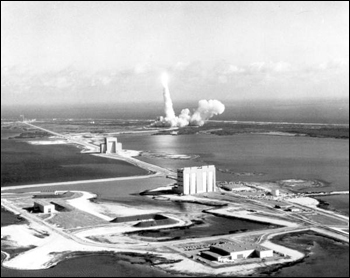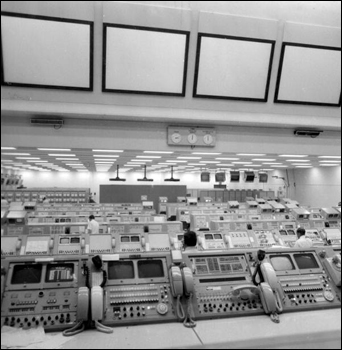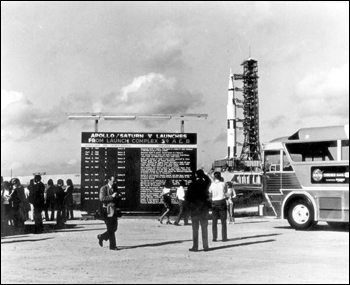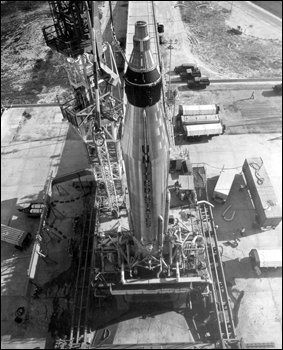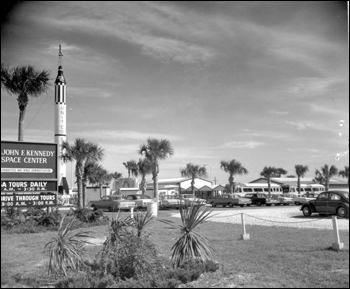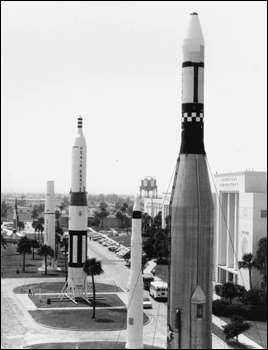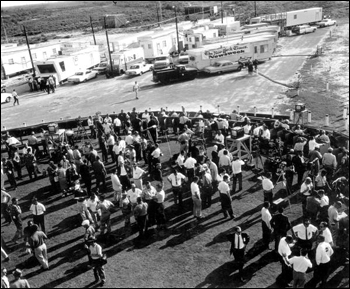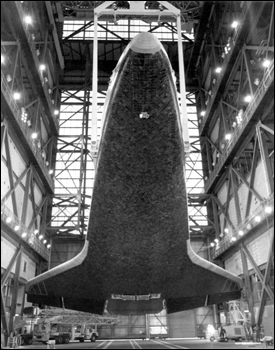Photo Exhibits
Photo exhibits spotlight various topics in Florida history, and are accompanied by brief text intended to place selected materials in historical context.
NASA Turns 50
Florida's Half Century on the Space Age Frontier
Changing Landscapes
Florida was geographically very well suited as the location for America's spaceport, but far-reaching and gargantuan-in-scale infrastructure development was needed to not only build and launch spacecraft, but to support the other high-tech industries necessary for the mission.
Titan III launch: Cape Canaveral, Florida (19--)
Image Number: RC09825
Computers and employees at the Kennedy Space Center: Cape Canaveral, Florida (1972)
Image Number: C679499
Tourists view the launch pad: Cape Canaveral Florida (1972)
Image Number: C680806
One of the photographic stops on the TWA/NASA Tour is Pad 39A where man has left the Earth to explore the Moon. Being viewed by Tour visitors is Apollo 17 which was launched in December of 1972.
The New Center for Space Exploration
Within ten years of Sputnik, under the direction of Lyndon Johnson, first as Senator and later as President, and with the leadership of President John F. Kennedy and others, American scientists and astronauts would be poised to put an American on the moon. During that decade, Florida's East Coast underwent a radical transformation as well, from sleepy agricultural region and vacation spot to world technological center.
NASA established a new space launch center on Brevard County's Cape Canaveral in 1962, following years of use as a missile testing center. The next year President Johnson renamed the center in honor of the recently assassinated John F. Kennedy. Florida's eastern seaboard had been the leading edge of America's ventures to the earth's extremes and beyond during the Cold War as the site of ICBM tests, and it would soon become the world's most important space port. The Space Age changed Florida forever, drawing thousands of new workers to the state and transforming Cape Canaveral into a hub of aeronautics, electronics design, and manufacturing. In addition, the development of the Cape spurred rapid growth along Florida's east-central coast and gave the state's tourist industry another valuable selling point.
As professor and historian, William Barnaby Faherty asserts, "geography chose Florida's East coast" as the ideal location for America's spaceport. The area was a sparsely populated (before development began in earnest) strip of flat land, facing thousands of miles of empty ocean, accessible to railroad and deep water transport, and near enough to Caribbean islands for them to serve as monitoring and communication stations. Farmers and other landowners were bought out to clear the way for NASA development, and the infrastructure necessary for a space center began to expand across the once idyllic cape.
Mission Control Operator Gene Kranz said of the effort it took to put Americans in space, "we could depend only on a learning curve that started at a place that wasn't more than a complex of sand, marsh, and new, raw concrete and asphalt. It wasn't even Kennedy Space Center then. But it was our first classroom and laboratory." (Gene Kranz, Failure is Not an Option, 13.)
View of Atlas Missile 10D with Mercury Capsule installed: Cape Canaveral, Florida (1959)
Image Number: C038461
Visitors' center and entrance at Kennedy Space Center: Cape Canaveral Florida (1967)
Image Number: C672739
View of Patrick Air Force base (1966)
Image Number: PR10173
Kennedy Space Center and the Expanding Florida horizons
Upon its creation, President Eisenhower transferred to NASA all the nation's non-military space projects, including all of the National Advisory Committee for Aeronautics (NACA) facilities; the Langley Laboratories and Wallops Test Station in Virginia; the Lewis laboratory in Ohio; and the Ames Laboratory and Muroc Flight Station in California.
"In 1960 the Cape looked like an oil field, with towering structures, dirt, and asphalt roads newly carved out of palmetto scrub," said Gene Kranz.(Kranz, 13.)
April 21, 1961, 27-year-old Russian cosmonaut Yuri Gagarin orbited the earth, and the United States and President Kennedy felt the need to up the ante even further for a dramatic response to the Soviet Union's advances. Two weeks later, Alan Sheppard conducted the first American manned flight of a vehicle in space. Then, on May 25, 1961, President Kennedy staked out the nation's ambitions as lofty as possible, to put a man on the moon and bring him back safely within the next ten years.
NASA announced in August 1961 that it would expand the Cape Canaveral facilities by 80,000 acres, developing the Merritt Island area north of the Air Force Missile Test Center that had been in active use since the early 1950s.
The space industry brought dramatic changes to Florida's landscape and economy. Rapid construction necessitated extensive infrastructure development in Brevard County. When the space age came to Florida, traditional Florida industries such as tourism embraced images of rockets, astronauts and space exploration, as well as the promise of new tourism and thousands of new permanent and temporary residents.
In summer 1963, construction began on the Vehicle Assembly Building, where rockets would be built and readied for transport to the launch pads. Upon its completion three years later, the VAB was for a time the largest building on earth, with an enclosed area of 129,482,000 cubic feet and standing 525 feet tall.
Visitors and journalists at the Air Force base: Cocoa Beach, Florida (1963)
Image Number: C621931
Space Shuttle Columbia preparing for completed assembly (1980)
Image Number: PR10265
The Space Shuttle Columbia is slowly raised and prepared for mating with its external tank and solid rocket boosters which will complete assembly of the first Space Shuttle vehicle.

 Listen: The World Program
Listen: The World Program